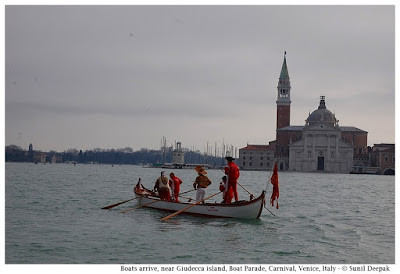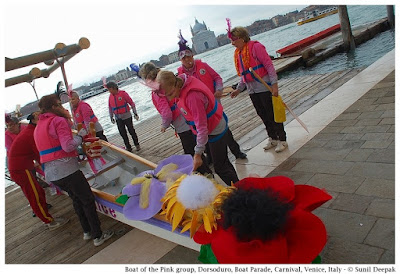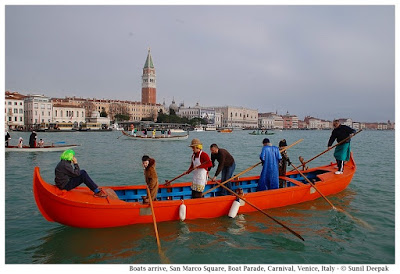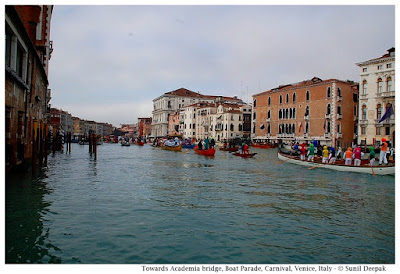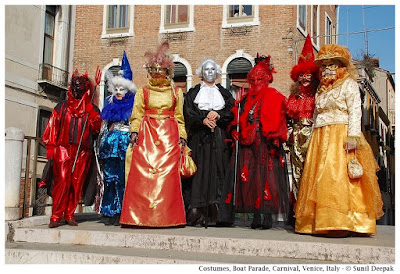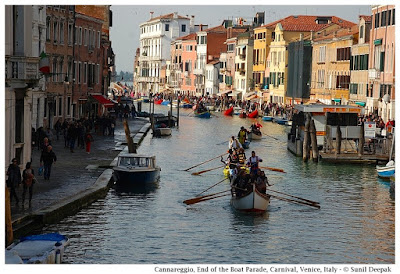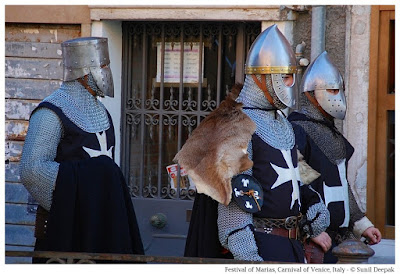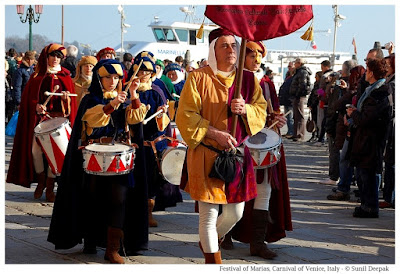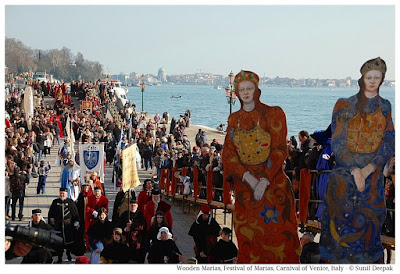Monday, 6 June 2022
Schio's Cosplay Meet
Monday, 18 December 2017
The wonderful world of Steam-Punk
Costumes and make-believe worlds
People have always loved dressing up in costumes, for example, in the Venice carnival.
The Punk style with striking costumes and colourful spiked hair styles made their appearance in the 1970s. In the 1990s, imaginary worlds of science fiction and fantasy, led to different movements like cyber-punk and diesel-punk. For example, during the 1990s, while living in Bologna (Italy), I came across groups of young persons, living as homeless urban vagabonds, with long matted hair and dogs. They were known as Punkabestia (beast-punk). The Steam-Punk movement also started in those years.
In more recent years, role-play games and fantasy worlds have become popular and are called Cosplay. I love the colourful Cosplay costumes.
Steam-Punk Philosophy
Steam-Punk ideas were influenced by writers like Jules Verne and H. G. Wells. Scientific advances made in the 18th century such as the steam-ship and steam-engines play an important role in Steam-Punk.
Steam Punk is a retro-futurism - a retro (old) technology imagined as a future. It can mix digital technology with handmade art. For example, look at the amazing old rusty-looking digital camera used by the Steam-Punk enthusiast in the image below.
The steam-punk brings together modern costumes and some elements from Victorian era such as corsets, gowns and petticoats for the women, and waistcoats, long coats, top hats and bowler hats for the men.
The Steam Punk association of the north-east of Italy, whose members are featured in this post, came to Schio, where I live, during a recent cultural festival called the British Day. Among the group, they even had a look-alike queen Victoria (in the image below).
Conclusions
As our societies become more developed and as we have more free time, I think that movements like steam-punk will become even more common. They are a way of having fun. They are also a way of organising smaller communities around a common-interest, to escape from the anonymity of the modern urban life.
For me, it was an opportunity to learn about their striking and colourful world. That day, my favourite costume was a photographer with an ancient looking camera (in the image below) though I am not sure if it worked!.
***
Sunday, 20 August 2017
Boat parade at the Venice Carnival
Watching the Boat Parade
Venice is full of canals. Grand Canal is one of the biggest. Almost 4 km long it starts near the most famous square of Venice, San Marco Square, and ends near the railway station and bus stand. The Boat Parade celebrates the Grand Canal. Only rowing boats can take part in it - no motor boats are allowed.
My Experience of the Boat Parade
I took a train and reached Venice around 10 AM. From the railway station I turned right towards the famous three-bridges and to Santa Croce, and then along the smaller canal towards Santa Marta which hosts the Venice University (Ca' Foscari). It was along the small canal that I saw the first boats with people wearing costumes who were going to the parade.
Conclusions
My choice of going to Dorsoduro gave me an opportunity to spend a lot of time with boats and people as they were getting ready for the start of the parade. It was not very crowded and I really enjoyed this part of the day.
This choice meant that I could not see the boats passing under the bridges and the conclusion of the parade in Cannareggio. By the time I reached there, the parade was almost over.
However I do not regret my choice. The alternative would have been to go early, find a good place on Academia bridge or Rialto bridge and wait for boats to pass underneath. Since the carnival attracts thousands of persons, you can't do everything, you can only do one thing. May be another time I will go early and stand at Rialto bridge to look at the boats as they come across the Grand Canal!
***
Update 28 January 2024
After 7 years, I was back in Venice for the boat carnival or the Corteo Acqueo and I redid the initial part of my visit exactly as I had done in 2017, with completely different results. This year the boat carnival had a few miserly boats and none of the colours and fun I had seen in 2017. The boats were supposed to start from the Punta della Dogana (right across St Mark square, near Santa Maria della Salute church) at 11 AM but even by 11.30, there were no boats, and no costumes that I could see - not even one. I asked the local gondola-men and they told me that it was late. When the boats came and went, I missed them completely, as to pass the time, I was visiting the Santa Maria della Salute church. As I came out of the church, I heard people talking about their disappointment.
I could think of two reasons why this carnival event did not work out so well this year:
(1) Early carnival dates and cold temperatures: This year carnival is early and in these weeks north Italy is going through near zero temperatures even in late mornings. Probably because of this, all the neighbouring cities which bring their boats for the carnival probably decided to stay away. It was a foggy and cold morning.
(2) During Covid, for a few years, this event did not take place and may be, it has not yet gone back to its old splendour.
Looking at this year's carnival programme, I have not seen anything about the parade of the Marias, usually on the last sunday before the carnival-tuesday. Since the selection process of the 12 Marias is going on, this is probably due to the cold, perhaps they can't go around in their princess-dresses in this cold.
So, as a learning from this experience, I think that if you have to plan yor carnival visit, this year may not be the best time - better to look for a year when carnival falls in late February or March! But if you are only interested in beautiful costumes, I think that they would be there, may be not as many but you will see them, in spite of the cold!
***
Monday, 10 July 2017
The angel queen of Venice called Maria
A Brief History of the Festival of Marias
Around 9th century CE, the Republic of Venice had a tradition linked with the religious festival of “Purity of Maria” and was celebrated on 2nd February of each year. During this festival, 12 beautiful girls of Venice belonging to poor families were selected to be Marias. Each girl was provided beautiful clothes and jewellery by a rich Venetian family and helped to get married.
Thus, instead of selecting the poor girls, they started carrying wooden Marias with clothes and jewellery of the rich families. After the procession, the clothes and jewellery was returned to the owners.
However, Venetians did not like the idea of wooden Marias and they started throwing rotten vegetables at them during the processions. Doge, the ruler of Venice, tried with a law prohibiting the throwing of rotten vegetables but it did not have much impact and slowly, the festival procession was stopped.
This festival was revived in 1999 as a part of the Carnival celebrations. Now, it is organised on the first day of the Carnival, around 10 days before the Mardi Gras celebrations.
The selection process starts a long time before the carnival. Girls resident in the Venice province can take part in this process.
Procession of the Marias
The procession starts in the afternoon around 2.30 PM from San Pietro di Castello in Venice and culminates in San Marco square where the 12 Marias are officially presented to the people of Venice.
There are two groups of Marias in the procession – those of the previous year and those selected for the present year. They are accompanied by different groups of persons dressed in medieval costumes coming from Venice and neighbouring towns.
After the Festival of Marias
On Monday, a day before Mardi Gras (last day of the carnival), among the 12 Marias, one girl is selected to be Ms Carnival or the Queen Maria for the next 12 months, a kind of Miss Venice.
Conclusions
Venice is a unique city, unlike any other city in the world. During carnival, Venice becomes magical. Most people think that carnival means colourful costumes and masks on the weekend leading to Mardi Gras. However, Festival of Marias is a wonderful inauguration of the carnival celebrations.
Monday, 10 April 2017
The Dancing Gods of Thayyem
Hinduism is based on the idea of all pervading universal consciousness known as Brahman, which has no beginning or end. Thus, mountains, trees, animals, birds and humans, everything animate or inanimate are the expression of Brahman and indicate a unity of all life forms.
In Hinduism, this idea of Brahman is coupled with Gods, one deity for each of the millions of life forms. In Theyyam, the dancer asks a God to come and become manifest in his body. Thus, during the dance-ritual, the dancer becomes an expression of God.
In other parts of India, there are persons who can go into trance and become "a channel of God" to speak and interact with people. For example, in north India they call it "Devi aayi hai" or the "Goddess has come". However, in Theyyam the invocation of God in human body is formalised and accompanied by specific costumes and rituals.
Theyyam is widespread in northern parts of Kerala state, especially around the town of Kannur. Each village and temple has its own Theyyam based a specific God or Goddess or local hero.
There are about 450 kinds of Theyyams. Each Theyyam has its own day during the year when its function will be organised in the village. Theyyam dancers are only men, usually from Hindu lower castes. Only one kind of Theyyam dancers are women.
Theyyam Preparation and Ritual
Around three weeks before the Theyyam celebration, the dancers start a period of abstinence to purify their bodies and minds. One day before Theyyam, they carry out a special invocation prayer called Thattam.
On the day of Theyyam, the dancer prepares his make-up using natural colours. During the make-up, their faces will carry complex designs for their specific Theyyam God and they will wear the ritual dress which is created and maintained by the dancer's family. The facial make-up for each Theyyam is also known as "Face-writing". The costumes include an elaborate head-dress and a breast-plate.
After completing the make-up and putting on the costume, the Theyyam dancer is shown his face in a mirror. This ritual is called Mukhadarshanam. It completes the arrival of God in his body. From that moment he ceases to be seen as human and becomes the manifestation of a specific God or Goddess.
Challenges Facing the Theyyam Traditions
Usually Theyyam dancers do it as a part of their family tradition and there is no or little income from it. With increasing modernisation, urbanisation and technology, it is becoming difficult for individuals to maintain complex social traditions like that of Theyyam, even if it has deep roots in the myths and cultures of the local societies.
Traditions like Theyyam are also under attack because some persons look at them as superstitions, or old fashioned backward rituals. They ignore its social roots and relevance, and look at it in isolation.
Theyyam plays a social role in the complex hierarchy of castes among Hindus. For example, in an interview, a Theyyam dancer said that though socially he belongs to a lower caste, when he becomes Theyyam, persons of all castes including Brahmins and upper caste persons must bend before him and ask for his blessing.
Theyyam Face Make-up in Kochi Folk-lore Museum
The Folk-lore Museum of Kochi has a collection of wooden heads illustrating the different "Face-Writing" designs made for different Gods and personas used in Theyyam. One of these is shown below.
Theyyam ritual dances are organised in villages in north Kerala during winter - especially between October to April. There is a weekly calendar of Theyyam events happening in different villages around the city of Kannur. You can find out it from different websites - here are two examples - TheyyamCalendar and KannurTravel.
Thus, if you want to observe a Theyyam ritual dance in its local village context, check the calendar and plan your visit to Kannur.
Conclusions
I have only seen Theyyam as a part of cultural programmes, as street art and as museum artifacts. I have used the images from those different encounters with Theyyam in this post. However, I hope one day to visit Kannur and see it as part of the local spiritual-religious tradition.
***
PS: In 2018, I had visited Kunoor and visited the sacred ceremonies of Theyyam in 2 villages. I was accompnaied by a local guide. It was an unforgettable experience, not just for the beautiful and exotic costmes and dances, but for its spirituality.
Friday, 21 October 2016
Actors Prepare - From Ravan to Mahatma Gandhi
India - Actors of Ramlila and Other Sacred Stories
Let me start with some images from India. All these images are related to Ramlila, the enactment of Hindu epic Ramayan. During the days leading to the festival of Dusshera, hundreds of Ramlila plays are organised across big and small towns in northern and central parts of India.
The first image above is from the Bhaona enactment of Ramayan at the Majuli island in Assam (India). The actors were getting ready for the "Sita Swayamvar" scene, where princess Sita has to choose her bridegroom and different kings have come from all over India, hoping to marry her. The image shows the actor playing Lord Ram help one of the actors playing the role of a rival king, get ready.
I have some wonderful memories of watching Ramlila as a child at the DCM grounds near Rohtak Road in Delhi. I was especially fascinated by the figure of Ravan, the Rakshas king with ten heads, who kidnaps Sita. His booming laugh made me feel afraid, but I also felt a bit of pity for him.
The image below is from Ser Jatra from Puri in Odisha during which actors wear masks and go in a procession. The image shows the actor playing Ravan getting ready with a ten-headed black mask, along with an actor playing Arjun (from the epic Mahabharat).
In Delhi, one of the oldest Ramlila traditions is from Chandni Chowk in the old city, started during the reign of Mughal king Bahadur Shah Zafar. This Ramlila play takes place in the open grounds at Ajmeri Gate, known as Ramlila grounds. The actors of this Ramlila get ready at a Dharamshala near Esplanade Road in Chandni Chowk. The image below shows the actor playing Lord Ram's younger brother Lakshman, get ready. The make up man is Mr Shyam Chandra Trikha who has been doing make up for this Ramlila for the last 25 years.
Often people playing actors say that for them playing a role in Ramlila is a kind of sacred benediction.
The last image of the Ramlila actors is from Kochi in Kerala, at the southern tip of India. The Kathakkali actor is getting ready for a temple dance-drama performance. Kathakkali has specific rules about the colours to be used for the make-up of different characters.
The next three images are of characters from other sacred stories of India. The first is of the Goddess Durga and is from the Ser Jatra in Puri in Odisha. The person getting ready to wear the Durga mask is a man, Mr. Bhimsen Mahapatra.
From Sikkim in the north to Kerala in the south, India has a wonderful tradition of using masks in the traditional theatre and dances. The use of masks provides ready-made faces for theatre, thus avoiding the need of spending hours on make-up. The next image has the masked Buddhist monks from Sikkim in the traditional Vajra (Lightening) dance.
The last image is that of Mr. Sunil Kumar getting ready to play Yamraj, the god of death, for the Ramlila procession in Chandni Chowk (Delhi), where he is going to sit with a noose around the head of an actor playing Markandeya.
The story of Yamraj and the boy Markandeya, where the boy is saved from death by Lord Shiva, appears in two sacred texts - Bhagwat Puran and Mahabharat. I ask him, why there are Yamraj and Markandeya in a Ramlila procession, since they are not a part of the Ramayan story? With his flashing eyes and a shining scimitar, Sunil Kumar does look a little scary, till he smiles at me benevolently, shaking his head. He would make for a wonderful image in the procession and their audience knows their story, so it is does not matter if he is a visiting celebrity from another sacred story.
Actors prepare in Europe
The next few images are from Bologna (Italy) where I had my first experiences of watching actors prepare for their roles.
The next image is of Mario Barzaghi, an Italian theatre actor and dancer who is also a trained Kathakkali dancer, getting ready for his role as Hanuman from the Indian epic Ramayan. This image can give you an idea of hours of preparation needed for the make-up and putting on of the Kathakkali costumes. The day I had clicked this picture, he was going to enact the episode when Hanuman flies to Lanka in search of Sita.
It is said that early Romans and Greek actors did not use any make-up or costumes. The use of the masks in the plays came much later. The traveling actor-comedians of the Italian Commedia dell’Arte in the 16th century had developed a set of stock characters, such as Arlecchino, who used masks. The image below shows some medieval puppets from the Bargellini museum of Bologna, wearing iconic costumes and masks of the Commedia dell'Arte era.
Introduction of electricity in the 19th century provided better lighting for theatre. Thus actors had to change their make-up techniques to adapt to the lights on the stage. In 1890 Carl Baudin used a mixture of flesh-coloured paste of zinc white, yellow ochre, vermilion, and lard, which was given the name of grease-paint. Even today often we use the term grease-paint to talk about the make-up of actors but with time, now we have much better water-soluble make-up. Rather than flashy and gaudy colours, modern theatre prefers the natural look with its own techniques of make-up.
The next three images are all from cultural events in Bologna showing actors putting on the make-up with water soluble colours to paint rainbows on their bodies.
The last image above has my friend Jana Daniela as the make-up artist. Jana herself is a cinema actor and has used amazing make-up for her role as a zombie in a recent film.
Actors From Americas
The next image shows animal-masks used by a Brazilian dance group from south America.
The second image from Americas is from Washington D.C. (USA) where the two actors of Indian origin, Subodh Sen and Natwar Gandhi, are getting ready respectively for the roles of Jinnah and Mahatma Gandhi for the play "A Tryst with Destiny", about the independence of India.
Conclusions
Selecting images for this post was immensely pleasurable. I loved going through my image archives to search for them, and in the process, rememberd many of those performances and the persons behind the make-up.
The concluding image of this photo-essay is of Mario Barzaghi getting ready to play Hanuman for the Kathakkali performance.
***
This Year's Popular Posts
-
Note (2022) : I had written this post in 2006, to share my own ragging experiences. It is about my positive experiences of ragging in earl...
-
A visit to the Jan Jaati Sanghralaya (Tribal Museum) of Bhopal (Madhya Pradesh, India) brought back the memories of my childhood. If anyone...
-
" Why don't you make a film on the issue of disability and sexuality? ", I had asked Arun while we were out on a walk. After ...
-
Before coming to Assam in the north-east of India, I had never thought of Shiva and Kali as a couple and I had also never thought of the two...
-
Finally I am ready to start with my Guwahati city walks – discovering this city through easy walking tours. For the first Guwahati tour I h...
-
Recently I was reading the wonderful book Sapiens: A Brief History of Humankind by the Israeli writer Yuval Noah Harari (originally writte...
-
Last year I visited some beautiful places in Bundelkhand in central India. However, you won't find "Bundelkhand" on the map of...
-
The extensive and ever-increasing network of the Delhi Metro has made it relatively easy to discover different parts of Delhi. This post is...
-
A Scotsman, Robert Bruce is credited with the “discovery” of tea in Assam in India. I think that it is anachronistic that 70 years after the...
-
This post has been published by me as a part of the Blog-a-Ton 22 ; the twenty-second edition of the online marathon of Bloggers; where w...


















